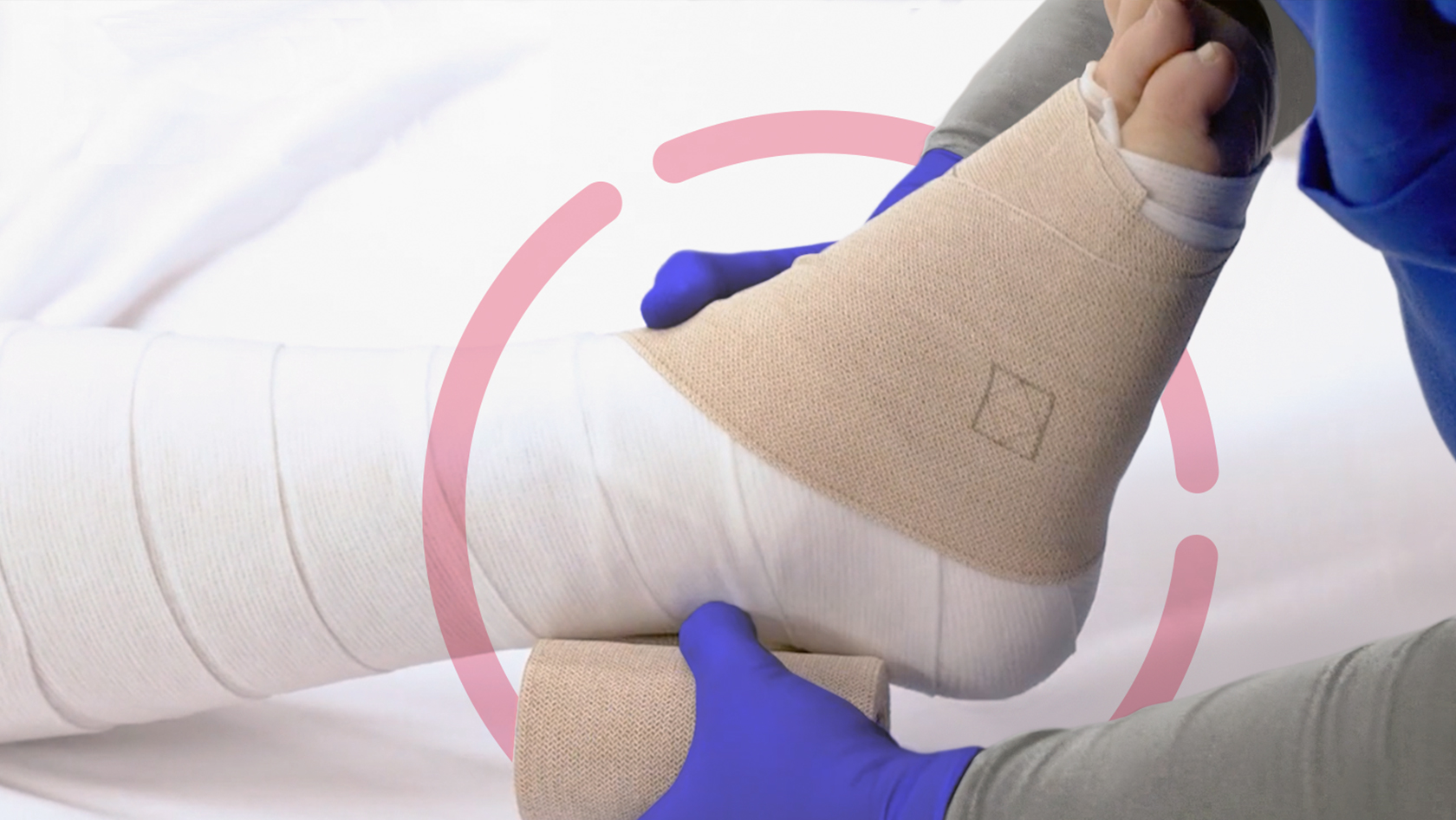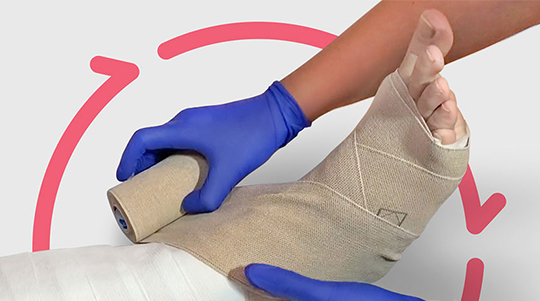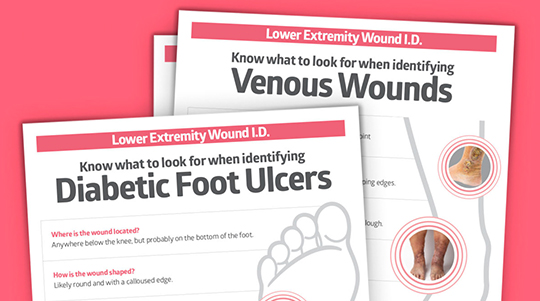Is an Unna boot the right choice to treat venous leg ulcers?
Stay up to date on venous stasis treatment options and drive better outcomes.

Venous leg ulcers are painful for patients and costly for the healthcare system. Old ways of thinking such as using an Unna boot wrap, can lead to poor outcomes. That’s why it’s important to empower nurses with information that helps them select the proper tools to help heal them faster and manage the underlying venous stasis disease.
“Nurses often do the same thing over and over because that’s all they’ve ever done,” explains Kim Kehoe BSN, RN, CWOCN, DAPWCA, Medline Clinical Education Specialist. “Nurses don’t necessarily understand the evolution in the product technology and how we can do things better now,” Kehoe notes. Inadequate treatment of venous stasis can lead patients to become frustrated and non-adherent, thus continuing the vicious cycle.
“Nurses don’t necessarily understand the evolution in the product technology and how we can do things better now.”

Kim Kehoe
BSN, RN, CWOCN, DAPWCA, Medline Clinical Education Specialist
Keep staff updated on treatment innovations beyond Unna boot compression to help achieve two goals:
- Build staff confidence to choose the right treatment tools from the outset, reducing healthcare cost, speeding healing time and improving patient quality of life
- Motivate patients to stick with treatment because they see that it’s working
Read on to learn about the evolution of venous leg ulcer treatment, from the first compression wrap to today’s clinically proven solutions that help staff follow evidence-based best practices, improve outcomes and help wounds heal.
.
The first compression, but not the last
You’ve heard it before: compression therapy is the gold standard for managing venous stasis and related leg ulcers. But where did that all start? Paul Gerson Unna was a German dermatologist who, in 1896, invented a gauze bandage impregnated with a zinc oxide paste. It was intended for the treatment of varicose veins, and thought to promote healing, provide moisture and soothe discomfort.2,3
That was a long time ago, though, and modern science has gone beyond Unna’s “boot” (UB). “Over the last 125 years, double-blind, evidence-based research has been conducted, including many meta-analysis articles, studying the efficacy of the Unna boot,” explains Elizabeth DeYoung, ND, FNP-BC, WCC, Clinical Education Liaison for the Medline Skin Health Solution.
“Anyone who has used UB for the treatment of venous leg ulcers will agree they can be effective, but there are many reasons why UB is not the recommended therapy,” DeYoung says. One of the biggest reasons, DeYoung points out, is that it can be difficult to sustain proper compression with the Unna boot’s cast-like properties.
“Anyone who has used UB for the treatment of venous leg ulcers will agree they can be effective, but there are many reasons why UB is not the recommended therapy.”
Elizabeth DeYoung
ND, FNP-BC, WCC, Clinical Education Liaison for the Medline Skin Health Solution
In the late 1980s, the first four-layer compression wrap system was introduced at a hospital in London.3 This method has advantages, but the four layers can be hot, bulky and painful for wearers when moving around. They may also get loose and slip, leading to both ineffective treatment and risk of skin irritation.3
All of these shortcomings can lead to increased healing times and greater patient non-adherence. Which brings us to the latest tools that solve for some of those challenges.
Compression and beyond: what to look for when considering advanced VLU treatment options
Over the past several decades, venous leg ulcer treatment options have evolved to include multi-layer and short-stretch compression therapy systems, as well as advanced skin and wound care to address infection, drainage and periwound skin.
When it comes to healing venous leg ulcers and managing venous stasis disease, look for products that offer important advantages. Help heal venous leg ulcers and manage venous stasis disease with products that include these 5 advantages:
- Intuitive product design—the easier a product is to apply, the more likely it is to be applied correctly
- Educational packaging—simple-to-follow instructions reinforce proper product usage every time
- People-friendly materials—when a therapy is more comfortable, people are more likely to adhere to it
- Improved durability—longer-lasting solutions drive cost savings
- Advanced ingredients—the latest scientific research can help heal and protect people from VLU recurrence
Check out these 6 innovative tools for venous stasis management
- AccuWrap® 2-Layer Compression Bandage System has specially designed accuracy indicators to ensure that even new or inexperienced nurses can achieve proper compression. “Thin, streamlined layering and breathable materials also make it easier for patients to tolerate the dressings, which increases adherence,” DeYoung says.
- COMPRECARES™ Compression Garment also improves patient adherence because it’s easy to apply and remove at home. “COMPRECARES is fantastic once the ulcer drainage and leg edema is controlled,” says Dawn Fortna, MSEd, RN, CWOCN, Medline Clinical Nurse Educator noting, “It’s removable to shower and removable at night if they sleep in bed.”
- The Medline Remedy® skin care system of products includes Hydraguard-D™, a silicone barrier cream that keeps intact skin moisturized and protected from breakdown caused by the effects of excess exudate. Nurses can use Calazime® skin protectant cream for even stronger barrier protection against the wet, open skin seen with venous dermatitis. Color-coded packaging makes it easy for staff to quickly identify the right product for their patient’s needs.
- Opticell® Gelling Fiber Wound Dressing uses biological material derived from crustacean shells in a special formulation that helps absorb heavy drainage. The educational packaging includes illustrations that clearly and simply show nurses how to apply the dressing.
- IoPlex™ Iodophor Foam Wound Dressing is designed with controlled-release antibacterial iodine to help control infection within the wound dressing.
- PluroGel® Burn and Wound Dressing helps manage biofilm, based on in vitro testing, and rinses off gently with saline or cleansers, making it more comfortable for patients.
Key takeaway
Advances in treatment options for venous leg ulcers arm nurses with more ways to help heal these painful wounds. Compression products have come a long way since the Unna boot. Innovations have made it easier for all clinicians to achieve therapeutic compression and more comfortable for patients to adhere to treatment plans. Skin care products and infection management close the gap on managing venous stasis disease and improving patient quality of life.
References:
- Bianchi, J., Flanagan, M., & King, B. (2020). 3D: A framework to improve care for patients with leg ulcers. Implementing person-centred diagnosis, evidence-based treatment decisions and inclusive dialogue with the 3D Framework. Journal of Wound Care, 29(Sup11c), S1–S65. Available at https://doi.org/10.12968/jowc.2020.29.Sup11c.S1
- Ferreira, I. G., Weber, M. B., & Bonamigo, R. R. (2021). History of dermatology: the study of skin diseases over the centuries. Anais Brasileiros de Dermatologia, 96(3), 332–345. Available at https://doi.org/10.1016/j.abd.2020.09.006
- Parks, P. (2017a, August). Advances in Compression Therapy for Treatment of Venous Leg Ulcers. Today’s Wound Clinic. Available at https://www.hmpgloballearningnetwork.com/site/twc/articles/advances-compression-therapy-treatment-venous-leg-ulcers




